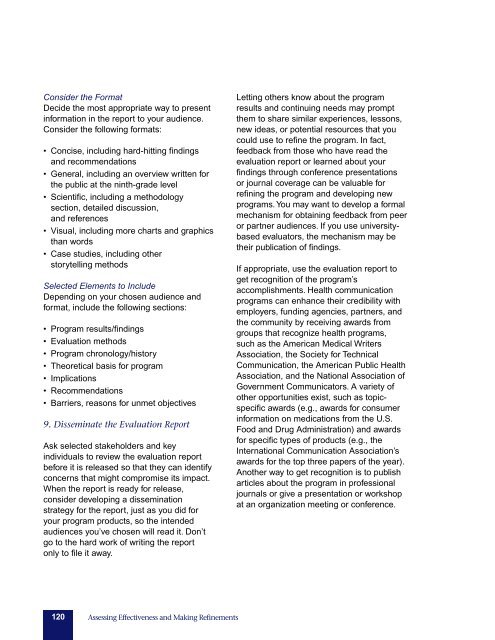pink-book
pink-book
pink-book
Create successful ePaper yourself
Turn your PDF publications into a flip-book with our unique Google optimized e-Paper software.
Consider the Format<br />
Decide the most appropriate way to present<br />
information in the report to your audience.<br />
Consider the following formats:<br />
• Concise, including hard-hitting findings<br />
and recommendations<br />
• General, including an overview written for<br />
the public at the ninth-grade level<br />
• Scientific, including a methodology<br />
section, detailed discussion,<br />
and references<br />
• Visual, including more charts and graphics<br />
than words<br />
• Case studies, including other<br />
storytelling methods<br />
Selected Elements to Include<br />
Depending on your chosen audience and<br />
format, include the following sections:<br />
• Program results/findings<br />
• Evaluation methods<br />
• Program chronology/history<br />
• Theoretical basis for program<br />
• Implications<br />
• Recommendations<br />
• Barriers, reasons for unmet objectives<br />
9. Disseminate the Evaluation Report<br />
Ask selected stakeholders and key<br />
individuals to review the evaluation report<br />
before it is released so that they can identify<br />
concerns that might compromise its impact.<br />
When the report is ready for release,<br />
consider developing a dissemination<br />
strategy for the report, just as you did for<br />
your program products, so the intended<br />
audiences you’ve chosen will read it. Don’t<br />
go to the hard work of writing the report<br />
only to file it away.<br />
Letting others know about the program<br />
results and continuing needs may prompt<br />
them to share similar experiences, lessons,<br />
new ideas, or potential resources that you<br />
could use to refine the program. In fact,<br />
feedback from those who have read the<br />
evaluation report or learned about your<br />
findings through conference presentations<br />
or journal coverage can be valuable for<br />
refining the program and developing new<br />
programs. You may want to develop a formal<br />
mechanism for obtaining feedback from peer<br />
or partner audiences. If you use universitybased<br />
evaluators, the mechanism may be<br />
their publication of findings.<br />
If appropriate, use the evaluation report to<br />
get recognition of the program’s<br />
accomplishments. Health communication<br />
programs can enhance their credibility with<br />
employers, funding agencies, partners, and<br />
the community by receiving awards from<br />
groups that recognize health programs,<br />
such as the American Medical Writers<br />
Association, the Society for Technical<br />
Communication, the American Public Health<br />
Association, and the National Association of<br />
Government Communicators. A variety of<br />
other opportunities exist, such as topicspecific<br />
awards (e.g., awards for consumer<br />
information on medications from the U.S.<br />
Food and Drug Administration) and awards<br />
for specific types of products (e.g., the<br />
International Communication Association’s<br />
awards for the top three papers of the year).<br />
Another way to get recognition is to publish<br />
articles about the program in professional<br />
journals or give a presentation or workshop<br />
at an organization meeting or conference.<br />
120 Assessing Effectiveness and Making Refinements


